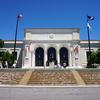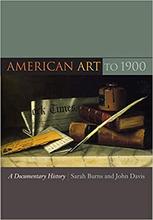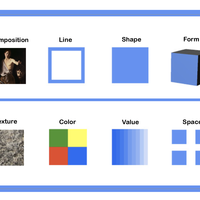More about Nocturne in Black and Gold, The Falling Rocket
- All
- Info
- Shop

Sr. Contributor
All Whistler wanted was to paint some fireworks, but what he got instead was a lawsuit and a filing for bankruptcy.
The Falling Rocket is one of Whistler’s six Nocturne paintings that showcase London’s Cremorne Gardens, which was the place to be for Victorian-era Londoners. Every night, people of all social classes could stroll the gardens enjoying live music, jugglers, bowling alleys, restaurants, taverns, and nightly fireworks shows. Two of the Nocturnes showcase the climax of the fireworks shows; the companion piece to The Falling Rocket is called The Fire Wheel, which sounds like a sick fireworks finale, and is at the Tate Britain.
Captivated, Whistler decided he must record them in paint. Unlike the Impressionists though, Whistler did not paint the scenes as he experienced them. Instead, he captured images in his mind and painted them in the studio. He thinned his oil pants to an almost colorless state to create the hazy, billowing smoke and deep darkness that envelop these works.
However, Whistler’s style and technique didn’t cut it for John Ruskin, an art critic who took a decidedly hateful stance against The Falling Rocket when he first saw it at London’s Grosvenor Gallery in 1877. The gallery championed art of the Aesthetic Movement, frequently showing artists like Whistler and Edward Burne-Jones. The Grosvenor became the hip and happening alternative to the strict measures of the Royal Academy, where artists could present their uniquely modern artworks. This was precisely what Ruskin hated and believed was ruining art itself. Instead, Ruskin believed that great art had social and moral messages, and he supported artists like Joseph Mallord William Turner and the Pre-Raphaelites.
Whistler’s technique in particular offended the critic’s sensibilities. Ruskin wrote a scathing review of the work, claiming that Whistler merely flung paint at a canvas and, in doing so, right in the public’s face. Whistler then sued Ruskin for libel, and the two faced each other in a highly-anticipated legal battle. The lawsuit essentially began the most essential question surrounding modern art: what is art’s purpose? Whistler helped to define the role of the modern artist, whose duty is to interpret what they see and feel and express that into their artworks.
Whistler ultimately won the suit, defending art’s right to be whatever it wanted. Ruskin, on the other hand, kept stewing in his hatred. He hated the industrialization of London and the debased society that capitalism was supporting, so it makes sense that he also disliked the notion of art for art’s sake, as well as the capitalism-fueled pleasures that took place at the Cremorne Gardens. It turns out that London society probably wasn’t ready for this free-spirited pleasure yet either. By the 1870s, the stiff and sensible upper class began to complain about the drunk and disorderly behavior that ruled the Gardens at night, and the Gardens closed in 1877. Today, you can visit still visit the park, but it’s a fraction of its original size and has way fewer prostitutes than it did in the nineteenth century. Bummer.
Sources
- Arnason, H.H. and Elizabeth C. Mansfield. History of Modern Art. 7th edition. Upper Saddle River, NJ: Pearson Education, Inc., 2013.
- Detroit Institute of Arts. “Nocturne in Black and Gold, the Falling Rocket, 1875.” Collection. Art. https://www.dia.org/art/collection/object/nocturne-black-and-gold-falli…. Accessed 7 October 2019.
- Figes, Lydia. “Who was John Ruskin?” Stories. Art UK. 8 February 2019. https://artuk.org/discover/stories/who-was-john-ruskin. Accessed 7 October 2019
- Fletcher, Pamela, and David Israel. “Grosvenor Gallery.” London Gallery Project. 2007. https://www.19thc-artworldwide.org/fletcher/london-gallery/data/pages/a…. Accessed 8 October 2019.
- Jackson, Hazelle. “Who to Cremorne would not Gladly Repair?” London Parks & Gardens Trust. 23 March 2015. http://www.londongardenstrust.org/features/cremorne.htm. Accessed 8 October 2019.
- Tate. “Nocturne: Black and Gold – The Fire Wheel.” Art and Artists. Artworks. https://www.tate.org.uk/art/artworks/whistler-nocturne-black-and-gold-t…. Accessed 7 October 2019.
- The Art Story. “Art for Art’s Sake.” Ideas. https://www.theartstory.org/definition/art-for-art/. Accessed 8 October 2019.
- Weinberg, H. Barbara, “James McNeill Whistler (1834–1903).” The American Wing. The Metropolitan Museum of Art. April 2010. The Heilbrunn Timeline of Art History. https://www.metmuseum.org/toah/hd/whis/hd_whis.htm. Accessed 8 October 2019.
Featured Content
Here is what Wikipedia says about Nocturne in Black and Gold – The Falling Rocket
Nocturne in Black and Gold – The Falling Rocket is a c. 1875 painting by James McNeill Whistler held in the Detroit Institute of Arts. The painting exemplified the art for art's sake movement – a concept formulated by Pierre Jules Théophile Gautier and Charles Baudelaire.
First shown at the Grosvenor Gallery in London in 1877, it is one of two works (the other being Nocturne in Black and Gold – The Firewheel) inspired by the Cremorne Gardens, a celebrated pleasure resort in London. One of his many works from his series of Nocturnes, it is the last of the London Nocturnes and is now widely acknowledged to be the high point of Whistler's middle period. Whistler's depiction of the industrial city park in The Falling Rocket includes a fireworks display in the foggy night sky. Nocturne in Black and Gold – The Falling Rocket is most famously known as the painting behind the lawsuit brought by Whistler against the art critic John Ruskin.
Check out the full Wikipedia article about Nocturne in Black and Gold – The Falling Rocket














